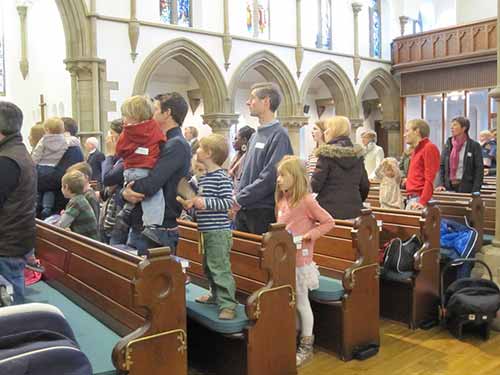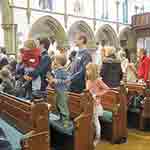
I had an interesting conversation this week that reinforced my prejudice. My friend talked about looking at the work and textbooks for, say, Maths, Physics, or Biology for senior secondary school students. And then my friend looked at the level of religious, ethical, and philosophical discussion used for similar aged students – that was at a far more naive, childish level. A student might be doing highly advanced work in other subjects, but for theology, our expectation is mostly that they have no such agility with the discipline. It’s a generalisation, sure, but we generally do not place the great philosophical and theological thinking before young people growing up.
Many churches have activities for children during services where those activities are well below their ability. When they are given a gift, children are often given gifts they will grow out of, not into. How many give a full Missal, a quality Study Bible, a New Zealand Prayer Book He Karakia Mihinare o Aotearoa – at a baptism? Something that they will have for life; something they will grow into not out of; somethings that will be treasured on their shelf an used as they grow up and on into adulthood.
My friend told me complex prayers he was taught as a very young child – with ideas that went beyond his understanding at the time but which he knew he would grow into; and they have stayed with him as companions into his adult life. He talked about adults around him having serious theological debates in his presence as a young child – theology and faith was for adults, for life, something to grow into. Sure, children have children’s needs that need to and can be met. But, you are getting my point: faith is for life – not something simply for children and the unintelligent – like the Tooth Fairy.
I reflected, recently, that we don’t ‘childify’ remembering war at our ANZAC service. Why might we do that with our faith?
My reflection on Children at the Eucharist in my book Celebrating Eucharist
Let’s hear some positive stories of treating children with the understanding that faith is something for life, to grow into, for adults. What gifts do you know of that can contribute to this perspective?
If you appreciated this post, do remember to like the liturgy facebook page, use the RSS feed, and sign up for a not-very-often email, …




I think that you are quite right. Prayers that I woas a child by heart, remain with me in memory now in my sixties. Particularly as I was Catholic and in the Care of Nuns as a child, and went to Catholic Schools. Mae first communion aged seven and was confirmed the next year.
I am now an Anglican and wonder how many parents pray at home with their children. Some do no doubt, but the level of the lack of familiarity with even the Lords Prayer evidenced when children start at Sunday School makes me wonder.
Perhaps we should periodically remind parents of the promises made at Baptism for their children to be raised in Christian homes, with prayer a feature they participate in from an early age.
Your suggestion about a prayer book is appropriate, although in the CofE we don’t really have a version of the Missal (that I had as a child, as did my own Children.
The BCP isn’t really age appropriate, written in 1662 language for young children, but is much more appropriate when they come to confirmation. The Prayer Book Society gave me a Personal Copy of the Cambridge Edition, in large print for my Licensing last year.
There are some useful Childrens Bibles out there, perhaps here, that might be the appropriate thing to present at a Baptsim?
Amen to all that, Ernie. Yes – with the reminder for parents could be/needs to be resourcing for them. And I understand about the CofE having abandoned one book – what about the Common Worship book; or Common Worship Daily Prayer? Blessings.
There’s plenty of possibilities if you wanted to give a book of prayers to a baptism family. One of my current go-to books is “The Heart In Pilgrimage: a Prayerbook for Catholic Christians”, edited by Eamon Duffy. It’s a pretty systematic introduction to different styles of prayer, and includes a simplified daily office. While it has a strong slant to (Roman) Catholic sources of prayer, it draws on a large pool of English-language prayers and reflections that even adults might grow into.
Thanks, Kieran. I will get a copy of that book. Blessings.
The Common Worship Daily Prayer and the General Common Worship books are quite confusing if you are not used to either. But things of Beauty when you use them regularly.
I meant to add that we have a range of BCP services in our Parish. One on Sunday and One mid-week on Thursday. We also have Evensong.
I would love to do Sung Matins as well, but our main congregation are used to HC (CW) and Service of the Word (CW).
We will shortly be in vacancy, and I will be taking the lead on Worship for a while. I have led Evensong, including doing the Sung Parts, which I had some concerns about, but it works well. But have never had the opportunity to lead Matins. But we have an Enthusiastic Choir Director, who is keen too try it out.
But will have to get it past PCC first 🙁
Yes Bosco, Amen to this. Somehow we need to convey to children that faith is the life we grow into rather than the life we outgrow.
Surely the ‘childification’ of faith is reflected in the beliefs of many people who might have had a Sunday School education but took it no further. Many profess a belief that has not matured (perhaps because it has not been nurtured) that is little more than ‘Jesus wants me for a sunbeam’ mentality.
I still have the baptismal Catholic Prayer Book my Godparents gifted me ( I would have been a few weeks old ) and the John Brown Self-interpreting family Bible which became officially mine when my grandmother died during my twenties. But I read it a lot as a child, it was my first exposure to Greek and Hebrew. Growing up in England we did receive a traditional Religious Education curriculum in school, which included the history of the King James Bible and the Orthodox and Protestant faiths, then later ethics, philosophy and comparative religion.
I do remember doing ( Methodist ) Sunday School too, a Sunday afternoon Bible story and song followed by a suitable craft! But in actual church services children, even babies, stayed in place and were expected to sit quietly!
My favourite services were of course the nativity, the late night service on Christmas Eve, and Harvest Festival when the church was decorated with flowers, fruits, vegetables plus wheat sheaves and ceremonial loaves and baskets of food which were subsequently distributed to the poor and elderly ( this was pre-EU food handling regulations! )
I don’t remember seeing Christmas trees in church as a child, but various size nativity scenes, and an advent candle. Most services throughout the year had fresh flower arrangements. We did process on Palm Sunday waving palm leaves or paper representations of them and we were allowed to take home a woven cross apparently made from trees in ‘The Holy Land’. We all had ‘mission boxes’ to collect coins which were sent to specific projects overseas. Eucharist was ‘communion wine’ which was Harvey’s Bristol Cream sherry in thimble-size glasses and tiny cubes of bread, children and adults the same.
Wonderful stories, thanks, Tracy. Blessings.